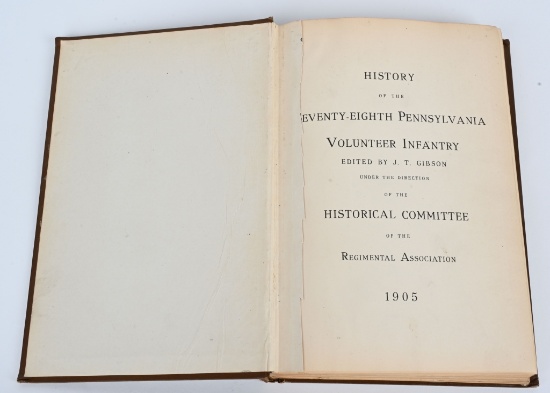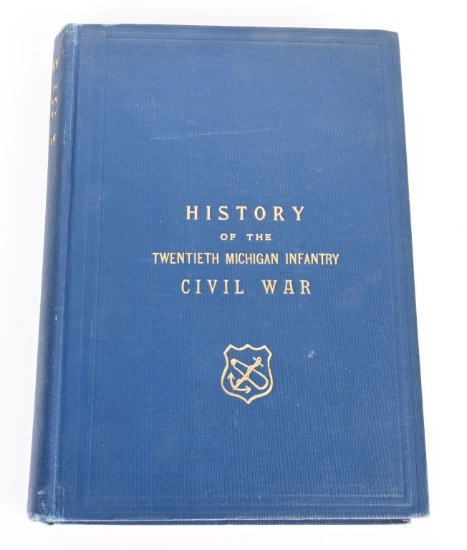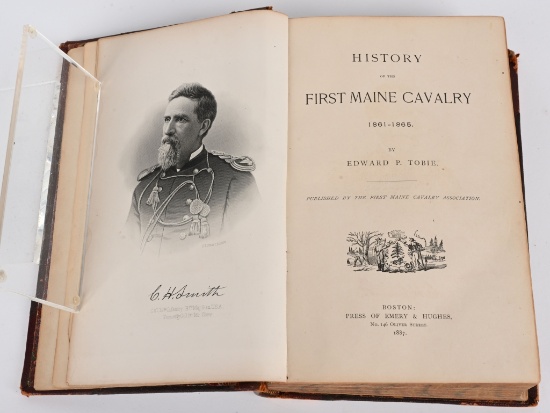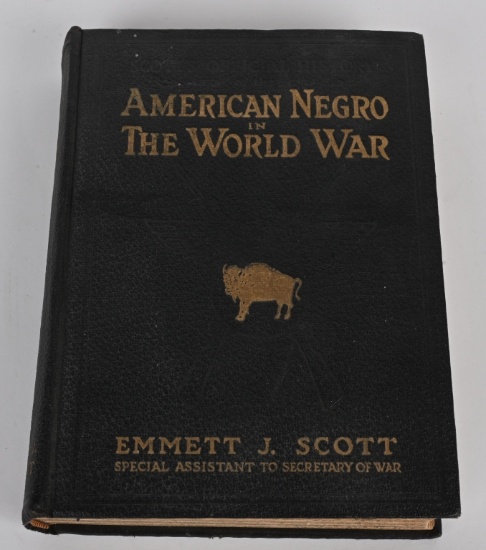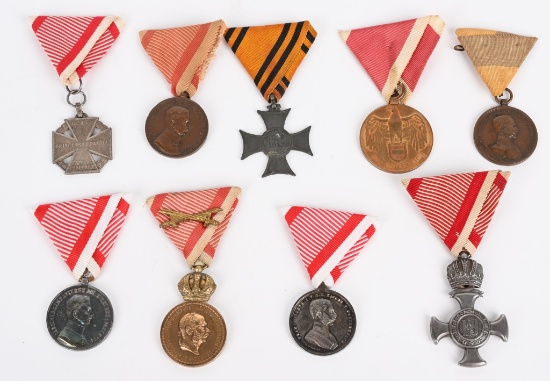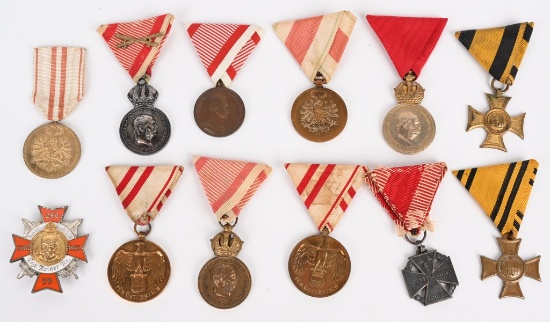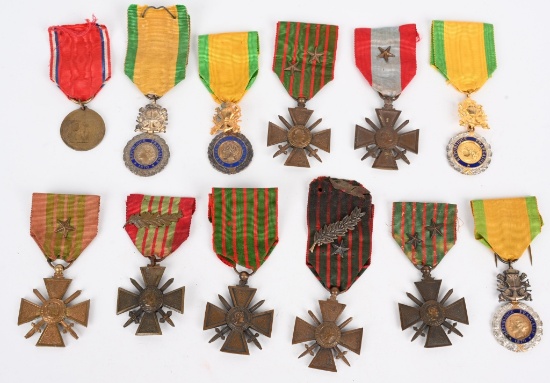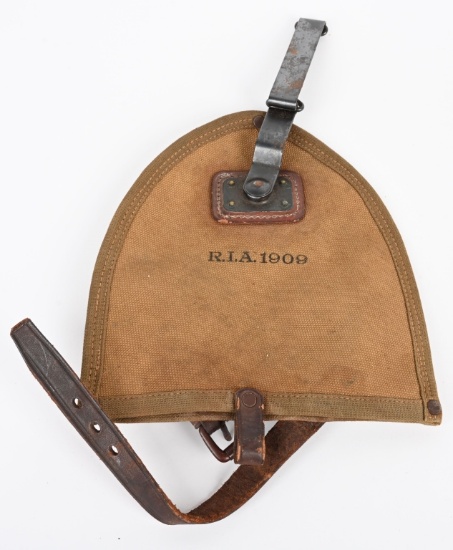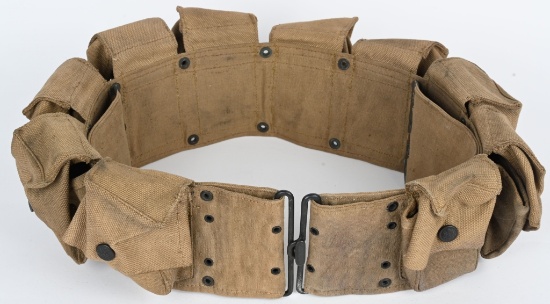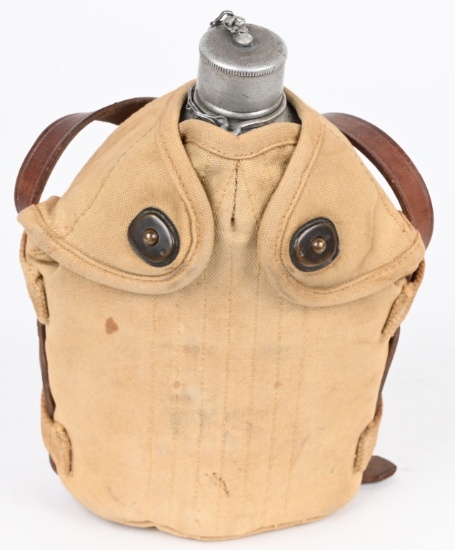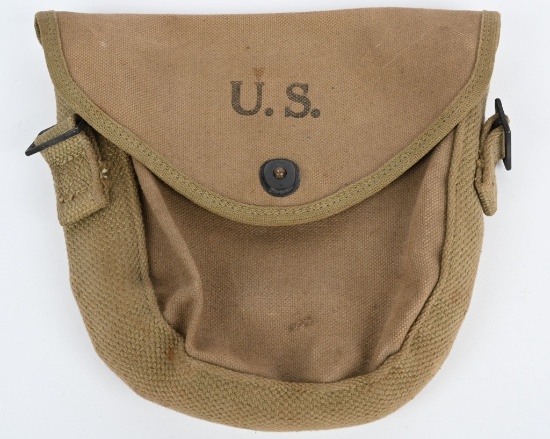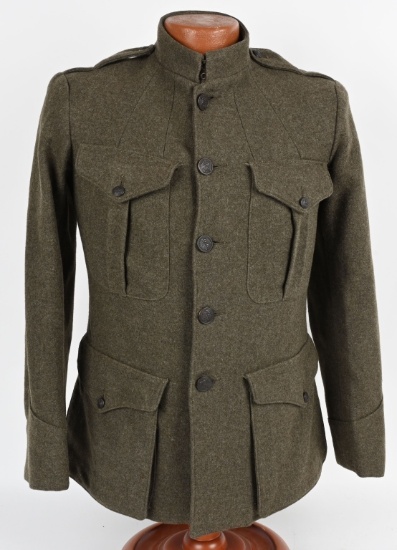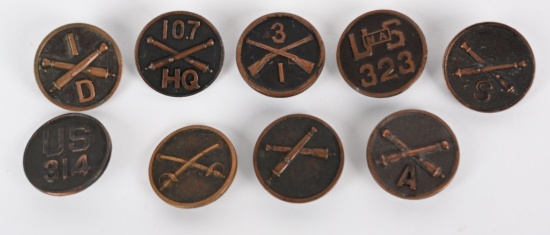Lot # 139 (Sale Order: 154 of 896)
Low Estimate: 200High Estimate: 300
Civil War unit history of the 1st Maine Cavalry published in 1887 having a complete roster of the Infantry Regiment. Excellent 1st Regiment, Maine Cavalry OVERVIEW: Organized at Augusta and mustered in November 5, 1861. Companies "A," "D," "E" and "F" moved to Washington, D. C., March 14-19, 1862; Companies "B," "I," "H" and "M" March 19-24, and Companies "C," "G," "K" and "L" to Washington March 19-28, 1862. Attached to Miles' Railroad Brigade, Army of Potomac, to May, 1862 (Cos. "A," "B," "E," "H" and "M"). Hatch's Cavalry Brigade, Banks' 5th Army Corps, and Dept. of the Shenandoah, to July, 1862 (Cos. "A," "B," "E," "H" and "M"). Abercrombie's Brigade, Williams' Division, Banks' 5th Army Corps, and Dept. of the Shenandoah, March to May, 1862 (Cos. "C," "D," "F," "G," "I," "K" and "L"). Bayard's Cavalry Brigade, Dept. of the Rappahannock, to July, 1862 (Cos. "C," "D," "F," "G," "I," "K" and "L"). Bayard's Cavalry Brigade, Army of Virginia, to September, 1862. Bayard's Cavalry Brigade, Cavalry Division, Army of the Potomac, to January, 1863. 1st Brigade, 3rd Division, Cavalry Corps, Army of the Potomac, to June, 1863. 2nd Brigade, 2nd Division, Cavalry Corps, June, 1863. 3rd Brigade, 2nd Division, Cavalry Corps, to October, 1863. 2nd Brigade, 2nd Division, Cavalry Corps, to October, 1864. 3rd Brigade, 2nd Division, Cavalry Corps, to August, 1865. SERVICE: Companies "A," "B," "E," "H" and "M" ordered to Harper's Ferry, W. Va., March, 1862, and guard duty along Baltimore & Ohio Railroad till May 19. Moved to Strasburg and operations in the Shenandoah Valley May 15-June 17. Action at Woodstock May 21, Strasburg May 22 (Cos. "H" and "M"), Middletown May 24. Winchester May 25. Retreat to Williamsport May 25-26. Winchester June 3. Milford June 24. Reconnoissance to Front Royal June 29-30. Luray June 30. Rejoin Regiment at Warrenton July 10. Companies "C," "D," "F," "G," "I," "K" and "L" moved to Warrenton March, 1862. Reconnoissance to the Rappahannock April 16 (Co. "C"). Reconnoissance to Liberty Church April 16 (Detachment). Reconnoissance to Culpeper Court House May 4-5. Brandy Station May 5. Join McDowell at Manassas Junction May 25. Milford July 2. Winchester July 3. Sperryville July 5. Regiment scouting on the Rappahannock during July. Reconnoissance to James City July 22-24. Slaughter House August 7. Robinson River August 8. Battle of Cedar Mountain August 9. Pope's Campaign in Northern Virginia August 16-September 2. Stevensburg, Raccoon Ford and Brandy Station August 20. Beverly Ford August 20. Fords of the Rappahannock August 21-23. Rappahannock Station August 24-25. Sulphur Springs August 27. Thoroughfare Gap August 28. Groveton August 29. Bull Run August 30. Mountsville, Centerville, Chantilly and Germantown August 31. Chantilly September 1. Frederick, Md., September 7 and 12. South Mountain September 14. Antietam September 16-17. At Frederick, Md., till November 2. Manassas Junction October 24. Middleburg October 30. Aldie October 31. Salem, New Baltimore and near Warrenton November 4. Rappahannock Station November 7-9. Battle of Fredericksburg December 12-15. Dumfries December 28. "Mud March" January 20-24, 1863. Rappahannock Bridge April 14. Stoneman's Raid April 29-May 8. Kelly's Ford April 29. Louisa Court House May 1-2. South Anna Bridge near Ashland May 3. Bealton May 10. Operations on Northern Neck May 20-26 (Detachment). Brandy Station and Beverly Ford June 9. Aldie June 17. Middleburg June 18-19. Upperville June 21. Hanover, Pa., June 30. Battle of Gettysburg, Pa., July 1-3. Steven's Furnace July 5. Hagerstown July 11. Funkstown, Md., July 12. Shephardstown and near Harper's Ferry July 14. Halltown and Charlestown July 15. Shephardstown July 16. Little Washington August 5. Beverly Ford August 15. Brandy Station September 6. Advance from the Rappahannock to the Rapidan September 13-17. Culpeper Court House September 13. Hazel River September 13. Raccoon Ford September 14. Culpeper September 20. White's Ford September 21-22. Bristoe Campaign October 9-22. Gaines' Cross Roads October 12. Warrenton or White Sulphur Springs October 12-13. Auburn and Bristoe October 14. St. Stephen's Church October 14. Blackburn's Ford October 15. Culpeper October 20. Near Bealton October 22. Rappahannock Crossing October 22. Rappahannock Station October 23. Advance to line of the Rappahannock November 7-8. Mine Run Campaign November 26-December 2. Morton's Ford November 26. New Hope Church November 27. Parker's Store November 29. Expedition to Luray December 21-23. Reconnoissance to Front Royal January 1-4, 1864. Near Salem January 3 (Detachment). Kilpatrick's Raid to Richmond February 28-March 4. Beaver Dam Station February 29. Fortifications of Richmond March 1. Brook's Turnpike March 1. Old Church March 2. Near Tunstall Station March 2. Rapidan Campaign May 3-June 15. Battles of Todd's Tavern May 5-6; Wilderness May 6-7; Todd's Tavern May 7-8. Sheridan's Raid May 9-24. North Anna River May 9-10. Ground Squirr
Civil War unit history of the 1st Maine Cavalry published in 1887 having a complete roster of the Infantry Regiment. Excellent 1st Regiment, Maine Cavalry OVERVIEW: Organ
...moreized at Augusta and mustered in November 5, 1861. Companies "A," "D," "E" and "F" moved to Washington, D. C., March 14-19, 1862; Companies "B," "I," "H" and "M" March 19-24, and Companies "C," "G," "K" and "L" to Washington March 19-28, 1862. Attached to Miles' Railroad Brigade, Army of Potomac, to May, 1862 (Cos. "A," "B," "E," "H" and "M"). Hatch's Cavalry Brigade, Banks' 5th Army Corps, and Dept. of the Shenandoah, to July, 1862 (Cos. "A," "B," "E," "H" and "M"). Abercrombie's Brigade, Williams' Division, Banks' 5th Army Corps, and Dept. of the Shenandoah, March to May, 1862 (Cos. "C," "D," "F," "G," "I," "K" and "L"). Bayard's Cavalry Brigade, Dept. of the Rappahannock, to July, 1862 (Cos. "C," "D," "F," "G," "I," "K" and "L"). Bayard's Cavalry Brigade, Army of Virginia, to September, 1862. Bayard's Cavalry Brigade, Cavalry Division, Army of the Potomac, to January, 1863. 1st Brigade, 3rd Division, Cavalry Corps, Army of the Potomac, to June, 1863. 2nd Brigade, 2nd Division, Cavalry Corps, June, 1863. 3rd Brigade, 2nd Division, Cavalry Corps, to October, 1863. 2nd Brigade, 2nd Division, Cavalry Corps, to October, 1864. 3rd Brigade, 2nd Division, Cavalry Corps, to August, 1865. SERVICE: Companies "A," "B," "E," "H" and "M" ordered to Harper's Ferry, W. Va., March, 1862, and guard duty along Baltimore & Ohio Railroad till May 19. Moved to Strasburg and operations in the Shenandoah Valley May 15-June 17. Action at Woodstock May 21, Strasburg May 22 (Cos. "H" and "M"), Middletown May 24. Winchester May 25. Retreat to Williamsport May 25-26. Winchester June 3. Milford June 24. Reconnoissance to Front Royal June 29-30. Luray June 30. Rejoin Regiment at Warrenton July 10. Companies "C," "D," "F," "G," "I," "K" and "L" moved to Warrenton March, 1862. Reconnoissance to the Rappahannock April 16 (Co. "C"). Reconnoissance to Liberty Church April 16 (Detachment). Reconnoissance to Culpeper Court House May 4-5. Brandy Station May 5. Join McDowell at Manassas Junction May 25. Milford July 2. Winchester July 3. Sperryville July 5. Regiment scouting on the Rappahannock during July. Reconnoissance to James City July 22-24. Slaughter House August 7. Robinson River August 8. Battle of Cedar Mountain August 9. Pope's Campaign in Northern Virginia August 16-September 2. Stevensburg, Raccoon Ford and Brandy Station August 20. Beverly Ford August 20. Fords of the Rappahannock August 21-23. Rappahannock Station August 24-25. Sulphur Springs August 27. Thoroughfare Gap August 28. Groveton August 29. Bull Run August 30. Mountsville, Centerville, Chantilly and Germantown August 31. Chantilly September 1. Frederick, Md., September 7 and 12. South Mountain September 14. Antietam September 16-17. At Frederick, Md., till November 2. Manassas Junction October 24. Middleburg October 30. Aldie October 31. Salem, New Baltimore and near Warrenton November 4. Rappahannock Station November 7-9. Battle of Fredericksburg December 12-15. Dumfries December 28. "Mud March" January 20-24, 1863. Rappahannock Bridge April 14. Stoneman's Raid April 29-May 8. Kelly's Ford April 29. Louisa Court House May 1-2. South Anna Bridge near Ashland May 3. Bealton May 10. Operations on Northern Neck May 20-26 (Detachment). Brandy Station and Beverly Ford June 9. Aldie June 17. Middleburg June 18-19. Upperville June 21. Hanover, Pa., June 30. Battle of Gettysburg, Pa., July 1-3. Steven's Furnace July 5. Hagerstown July 11. Funkstown, Md., July 12. Shephardstown and near Harper's Ferry July 14. Halltown and Charlestown July 15. Shephardstown July 16. Little Washington August 5. Beverly Ford August 15. Brandy Station September 6. Advance from the Rappahannock to the Rapidan September 13-17. Culpeper Court House September 13. Hazel River September 13. Raccoon Ford September 14. Culpeper September 20. White's Ford September 21-22. Bristoe Campaign October 9-22. Gaines' Cross Roads October 12. Warrenton or White Sulphur Springs October 12-13. Auburn and Bristoe October 14. St. Stephen's Church October 14. Blackburn's Ford October 15. Culpeper October 20. Near Bealton October 22. Rappahannock Crossing October 22. Rappahannock Station October 23. Advance to line of the Rappahannock November 7-8. Mine Run Campaign November 26-December 2. Morton's Ford November 26. New Hope Church November 27. Parker's Store November 29. Expedition to Luray December 21-23. Reconnoissance to Front Royal January 1-4, 1864. Near Salem January 3 (Detachment). Kilpatrick's Raid to Richmond February 28-March 4. Beaver Dam Station February 29. Fortifications of Richmond March 1. Brook's Turnpike March 1. Old Church March 2. Near Tunstall Station March 2. Rapidan Campaign May 3-June 15. Battles of Todd's Tavern May 5-6; Wilderness May 6-7; Todd's Tavern May 7-8. Sheridan's Raid May 9-24. North Anna River May 9-10. Ground Squirrless...
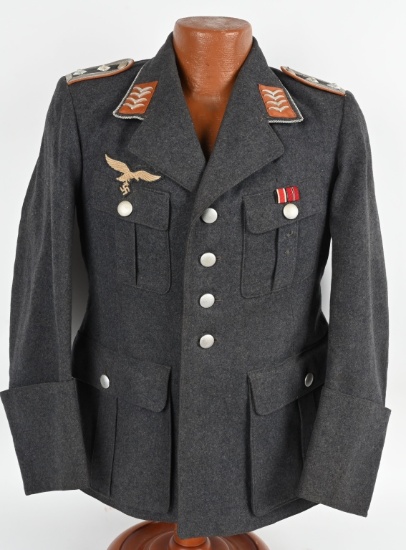


 x Cancel
x Cancel